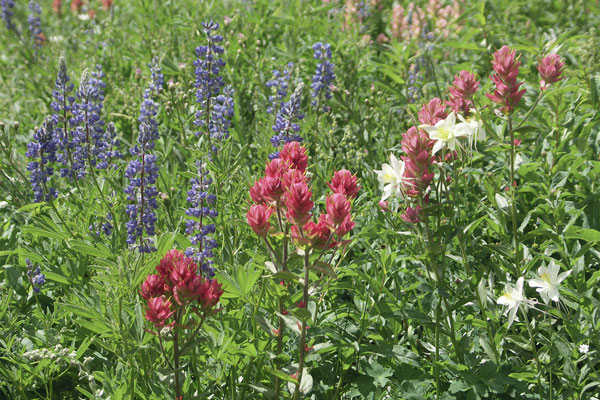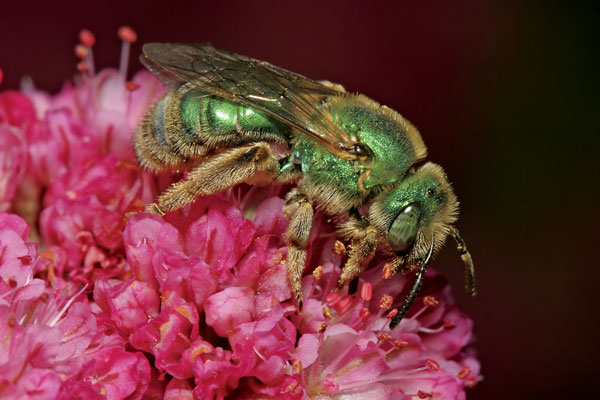Designing a Pollinator Habitat: Four Things to Consider
Creating a pollinator habitat can be as simple as planting a small garden. But to successfully support a diversity of species, don’t overlook factors like bloom time or how far different pollinators can travel.

Providing habitat for pollinators can be as simple as planting a small garden. Here are some key considerations when creating a welcoming space for pollinators.
Planting Layout
Groupings of single flower species reduce the energy required for foraging because pollinators can spot the plant quickly (minimizing their search time). And with an abundance of flowers in one location, pollinators can more quickly and efficiently from flower to flower and collect a full load of pollen and nectar to bring back to the nest. Research suggests planting flower groupings (clumps) of at least 3 feet (1 m) in diameter of an individual species. Large clumps of individual species are easier for flying pollinators to find in the landscape, especially in the case of small urban habitats or small pollinators with flight ranges as short as 500 feet (152 m).
Flight Range
The flight range of pollinators is a necessary consideration for restoration and management of pollinator habitat. The distance a pollinator can fly varies among species, and thus the distance between food and nesting sources must be carefully considered. This may be most important for bees because — unlike butterflies, flies, and beetles — they transport pollen and nectar to a nest and therefore are locked into visiting the flowers surrounding their nest. Other pollinators may forage much more widely, roaming across the landscape in search of food or egg-laying sites, sometimes over many miles — even hundreds of miles, as in the case of monarch butterflies.
The ideal is to have nesting and forage resources in the same area. Bees are able to adapt to landscapes in which nesting and forage resources, as long as these two key habitat components are not too far apart.
The distance a bee can fly between nest site and forage area is related to its size. Small species may fly no more than 500 feet (152 m) while larger species such as bumble bees may fly more than a mile (1.6 kilometers). A general rule of thumb is to have flowers no more than a few hundred feet (100 m) from potential nesting areas.

Plant Diversity
Diversity is a critical factor in the design of pollinator plantings. Natural flower-rich habitats may have 50 or 100 species, but for most conservation areas, as few as 10 carefully chosen plant species will provide a good foundation. Gordon Frankie, a professor at the University of California in Berkeley, and his students have found that when eight or more species of plants are grouped together at a single site, they tend to attract a significantly greater abundance and diversity of bee species. From this foundation, a richer habitat can develop with subsequent plantings, or by colonization from nearby natural areas. With several plant species flowering at once, and a sequence of plants flowering through the growing season, habitats can support a wide range of pollinators. If there are particular pollinators you wish to support, identifying and planting their key host plants may increase their abundance.
Including a diversity of plants with different flower sizes, shapes, and colors, as well as varying plant heights and growth habits, will support the greatest numbers of diversity of pollinators. Diverse plantings that resemble natural native plant communities are also the most likely to resist pest, disease, and weed epidemics. Plant species found in association with each other in local natural areas are likely to have the same light, moisture, and nutrient needs and are more likely to thrive when grouped together. Thus, it is very useful to look around at natural areas in your community to see what plants are growing together, and which of these flowers seem to have the most visitors.
Anatomy Plays a Role
The size of the pollinators, the length of their tongues, and the accessibility of nectar or pollen within the flower are all factors in determining the floral preferences of diverse pollinators. Many species of bees can feed from flowers such as asters that have simple structure and easily accessible nectar. Some bees (notably some bumble bees) have long tongues or are big enough to push petals aside; they sometimes prefer more complex flowers such as lupines and salvias in which the nectar is hidden deep inside, often with a higher concentration of sugar.

Bloom Time Succession
To provide a continuous food supply, choose at least three different pollinator plants within each of the three blooming periods: spring, summer, and fall. Under this plan, at least nine blooming plants should be established in pollinator enhancement sites; more is even better.
Include Early and Late Bloomers
It is especially important to plant flowers that bloom in the very early spring. These flowers are a critical resource for early emerging bees such as bumble bee queens, mining bees, and mason bees. An abundance of early to mid-spring blooming flowers will also help jumpstart populations of the handful of native bee species — such as bumble bees and some sweat bees — that produce multiple generations each year. These bees can be very abundant.
Adequate forage available early in the season will increase reproductive success and lead to more bees in the middle and end of the year. Early forage also may encourage bumble bee queens that are emerging from hibernation to start their nests nearby, or simply increase the success rate of nearby nests. It is equally important to include plants that flower late in the season to ensure that queen bumble bees are strong and numerous going into winter hibernation.

Text excerpted from Attracting Native Pollinators © The Xerces Society.










